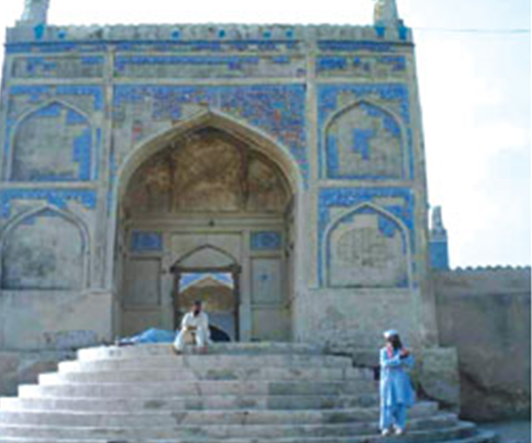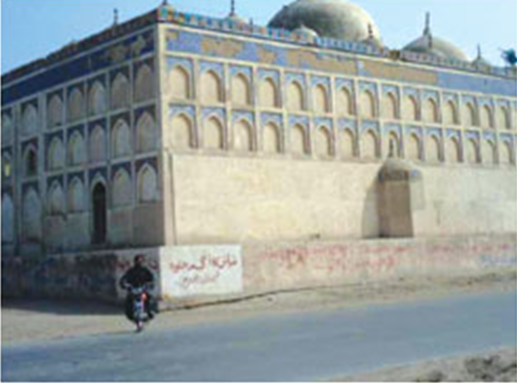Khudabad
This is a collection of articles archived for the excellence of their content. Readers will be able to edit existing articles and post new articles directly |
Khudabad
In need of care
By Qurban Ali Khushik
Khudabad is a famous town in Sindh. It is located on the right side of Indus Highway, between Sehwan and Dadu. From 1701 to 1750AD, Khudabad served as the capital of Sindh.
There is a renowned mosque in Khudabad known as Badshi Mosque or Jamia Mosque. Not just that, there are graves of King Yar Mohammad Kalhoro, his family members and ministers in the town, apart from some other historical sites of that period. At present, these sites are in a poor condition and no one seems to pay any attention to them.
These days, Kalhora, Panhwar, Jamali, Chandio, Leghari , Bhand, Magnejo, Barejo, Mashehori,Kumbhar, Channa, Jalbani, Birmani Khushik, and Bhutto tribes live in Khudabad and their only source of income is crop cultivation with the help of the water that they get from the River Indus.
Khudabad Mosque was built by the first ruler of the Kalhora dynasty, Mian Yar Mohammad Kalhora, between 1701 and 1718. The mosque is a remarkable example of that period’s exquisite architectural feats. It is built on a podium which is rectangular in shape. It is also known for the beautiful Kasi work on it. It is believed that 5,000 people used to offer their prayers at a time in the mosque during Yar Mohammad’s rule.
It was Mian Yar Mohammad Kalhoro who made Khudabad the capital city of the province because of its proximity with the River Indus. The town’s old name was Shikarpuri Panhwari; it was renamed Khudabad by Yar Mohammad Kalhoro in 1701AD when he came from Kalat and began to rule Sindh. It is said the prince of Multan, Moziuddin had arrested Mian Din Mohammad Kalhoro during a battle and Yar Mohammad Kalhoro managed to escape to Kalat. When he returned to Sindh his father Mian Naseer Mohammad and brother Mian Din Mohammad had taken control of the area. He declared himself king and made Khudabad capital of the province. Khudabad was the central place for business at the time as traders and tourists used to come from Central Asia and other places to do business and witness the town’s beauty. The revenue income of this historical city was 11,00,000 rupees annually. It is on record that the irrigation system here was improved by Kalhora rulers to cultivate thousands of acres of barren land.
Mian Yar Mohammad Kalhoro died in 1718. Subsequently, Mian Noor Mohammad Kalhoro, the son of Mian Yar Mohammad Kalhoro, was made king. In 1750 Mian Noor Mohammad Kalhoro handed over his government to his son Mian Murad Yab Khan who was then living in Iran. Mian Noor Mohammad Kalhoro died on December 9, 1753 in Jasalmir and was buried in the city of Mohammadabad. The importance of Khudabad got diminished when Mian Muradabd Yab Khan decided not to live in Khudabad. He instead lived in Muradabad near Nsarpur along the Indus River. Muradabad was destroyed completely because of floods in 1757. Nowadays there is no trace left of the old Muradabad town.
In 1832 General Napair succeeded in occupying Sindh. The British government cleaned the historical places through the local people and in 1932, as per the act of national heritage, these historical places were handed over to the archeological department.
These days, Khudabad is a neglected town. Many historical places are in a poor condition and no one seems to be bothered about it. There is an urgent need for repairing some of these sites.
In 1975, former prime minister Z. A. Bhutto released 200,000 rupees for Khudabad Mosque’s repair work but it was done in a such a way that the mosque’s original form was changed. In 1995, one tomb collapsed and another got damaged. The roof of the mosque is now standing with the support of pillars but can collapse any time. The condition of the tomb of Main Yar Mohammad Kalhoro, his family members and ministers is not well either.
Khudabad, Sindh
Historical property’s record changed
By Our Correspondent
DADU, July 17: The Anti-Corruption Establishment on Thursday lodged an FIR against a former mukhtiarkar and three tapedars on charges of changing revenue record of 450 acres of land belonging to the 18th century ruler of Sindh Mian Yar Mohammad Kalhoro and his family in Khudabad on the Indus Highway between Sehwan and Dadu.
The land is adjacent to the tomb of Mian Yar Muhammad Kalhoro. Also considered a saint by many, Mian Yar Muhammad Kalhoro was the first ruler of Kalhora dynasty who ruled between 1701 and 1718. He rebuilt Khudabad and declared it the capital of Sindh, which remained so from 1701 to 1750 AD.

